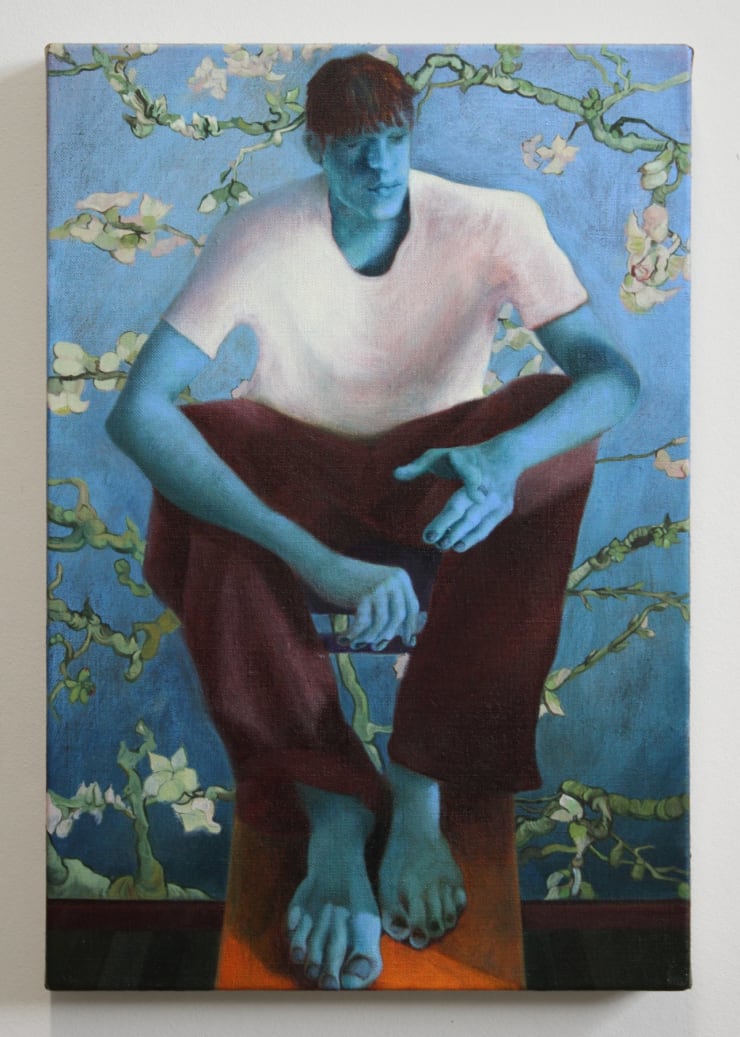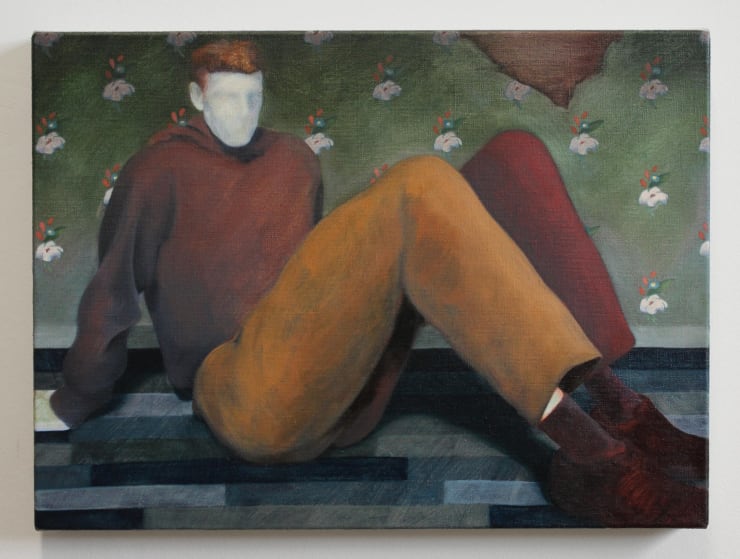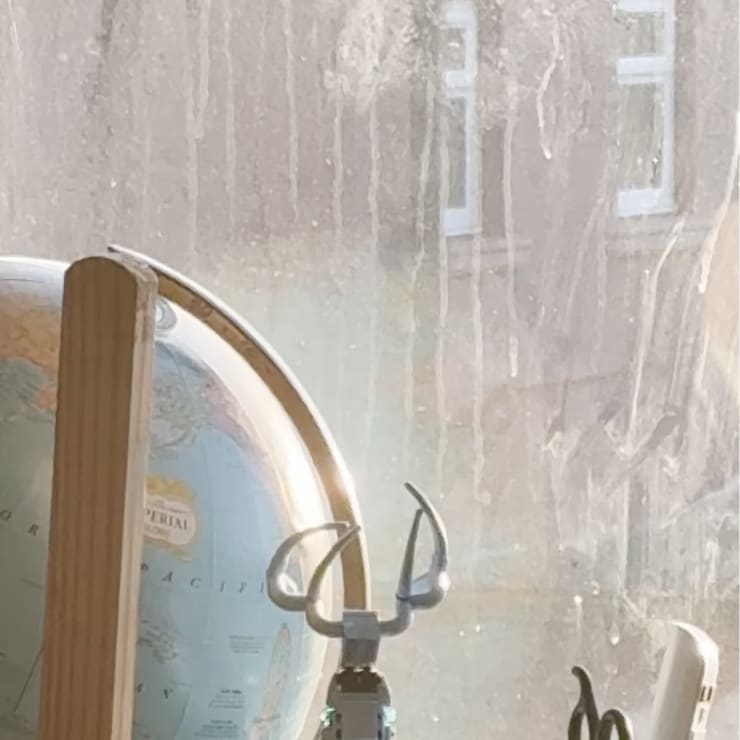Will Fice: Can You Hear The Rain?
-

-
Works
-
Artist Exhibition Statement
‘Can You Hear The Rain?’ presents 10 new paintings, with a focus on the representation of the single solitary male figure. The work continues to lend itself to ideas of male identity and significance but now chooses to put its whole attention into the individual. Each painting captures the figure, maximised within the border of the canvas; in a contemplative moment, either staring off into the distance or back at the viewer – separating itself from previous work which used scene to portray interaction between groups of young men. This body of work emerges off the back of a period of change and struggle which inevitably caused me to step away from painting for a short while. Firstly, becoming a dad at the end of 2022 and then losing my mum last year. The paintings are therefore reflective of the thoughts, feelings and emotions experienced as a result of grief and change during this period. Subsequently, the paintings have become more serious in tone. The use of colour has dimmed down whilst introducing small openings of light to bring a heightened sense of mood and atmosphere. The paint is applied in contrasting thickness and texture, incorporating thin washes and dry scratches of paint to certain areas across the canvas. The brush has become more expressive and gestural where in some areas the paint has been stretched or applied quickly through diagonal movements or scrubbed away and re-layered. As a result, the figures take on an almost ghostly presence where certain facial features fade, fog and glow. Small details such as the pattern of a wallpaper are integrated alongside these techniques to carry a sense of delicacy and beauty to the painting. These images serve as a window to which the viewer is subjected to the isolation and vulnerability of the figures. Subject matter sourced from found images online and fashion magazines, personal imagery and late 19th – mid 20th century painting are a starting point. Particular Images are then stretched and sometimes contorted, exaggerating certain forms when drawn on paper before moving onto canvas. Some areas are later re-modelled using my own body as reference when necessary. This level of distortion isn’t foreign to previous work but with a new founded approach, focusing solely on the single figure, form becomes greater imposed and plunges the viewer into an altered or even disorientating sense of reality. The exhibition uses its title as a means of assuring the solemn tone of the paintings. It suggests a quietness and brings forth the notion to pause and listen. In these works, the figures are both present and on the edge of absence. They’re distant and detached; emptied from any emotion. Through paint they become supernatural and otherworldly and reside within timeless and nameless spaces, some of which acting as a void revealing ethereal passages of light. As a collective whole this body of work divulges a fragility to the young male figure. In their solitude, personality is stripped away and we are confronted with an intimate reflection of existence. One which contemplates our sense of being and ephemerality as individuals in an ever-changing landscape.
Will Fice - February 2025 -
Essay by Matt Lippiatt
Can you hear the rain?Following a two-year hiatus, Will Fice returns with Can you hear the rain?, an exhibition of ten new paintings in which focus is shifted away from the male group dynamics that Fice has painted in the past, and onto lone individual men. The tone is more sombre than before, registering the impact of changing circumstances in Fice’s personal life – Fice recently became a father and lost his mother. Interaction is replaced by introspection, and this is carried over into formal choices: hue and pattern are reined back, in a deliberate push against the brightly coloured graphic style that Fice had employed in his previous exhibition, Beautiful Losers.Encountering the introverted figures in Can you hear the rain?, we might wonder if these are the same young men who populated Fice’s earlier work. No longer climbing trees or congregating in huddles, they appear to have parted and returned home alone. Together they killed time, smoked, drank, checked their phones – activities that could be continued individually, and yet all those activities are absent from the moments pictured in Can you hear the rain? We don’t even see a symbolic shadow or mirror image to hint at the multiplicity of a divided self. Instead, we’re presented with the human figure as a single self-contained unity, giving very little away. In the words of Aesop Rock: I pull my hood down, I got some walls up.Expression or introversion? Fice seems caught between the two, as the desire to communicate locks horns with an equally strong impulse to deflect and disengage. Bodies in these paintings are subject to distortion and heightened unnatural colour effects – the classic tools of expressionist painting used to convey heightened emotions by artists since the beginning of the last century (or further back still, if we include El Greco). But in Can you hear the rain?, these expressionist tendencies are held in tension by an unassuming body language of withdrawal. Arms are folded, heads turn away, and even the more open poses appear noncommittal. The only gesticulation in the exhibition is a single pointing finger, loosely gesturing beyond the frame, following the direction of the owner’s impassive thousand-yard stare.Fice taps into art’s mysterious and long-established connection between melancholy and elongation. We might ask: Why the long face?, as the very features that would usually clarify facial expression have been blurred into inscrutability. If eyes are the windows to the soul then these faces are mostly boarded-up buildings, with who knows what contained behind their blank facades. Most don’t appear to breath the air around them, nor do they disturb it by uttering a sound. They don’t see us, but we see them, which is the normal way of things with paintings, accentuated here with a curiously intimate sense of voyeurism. It’s like we’re watching someone sleep: so close, yet so far away.
Meeting the resistance of faces that are barely there, our attention falls instead to the hands, which are prominent in almost all the paintings here. Strong, large and heavy, they recall the sturdy working-class hands of twentieth century social realist pictures by Käthe Kollwitz, Ben Shahn, Peter Howson and Beryl Cook. But now these hands appear to be left hanging, evolved to grapple with a challenging material world, but increasingly made redundant by twenty-first century technology. (In this regard, there is a subtly optimistic synergy between these images of hands and the skilled manual labour that was required to render them on canvas – a quiet self-referential celebration of craft.) With nothing much to do, it is perhaps inevitable that these hands turn on themselves, picking idly at their own nails, or clasped in what might be an act of self-soothing.
Shortly before work on Can you hear the rain? was completed, the film maker David Lynch died. Fice doesn’t cite Lynch as an influence but there are striking parallels. Most obvious are the red velvet curtains that can be seen in two of Fice’s paintings here, and which were also a recurring motif in Lynch’s film and television work – especially Twin Peaks’ ‘red room’, an extradimensional zone where human characters where occasionally allowed to visit, sometimes in dreams, to interact with spirits. The red room’s velvet curtains appear to substitute for walls, creating an impression of somewhere uncannily familiar yet ominously undefined. Similarly, in Fice’s paintings the presence of red velvet curtains evokes an architectural space for the figures to occupy (“timeless and nameless places”, in Fice’s words), without nailing down exactly what kind of location this might be: public or private? A dressing room or a stage? Maybe neither. Any promise of theatricality seems thwarted by the men’s unwillingness to perform for us. There is feeling here, but no drama.
In the sparest paintings, Fice’s figures are set against nothing more than a subtly modulated colour field, like a photographer’s backdrop. The formal duality of figure and ground becomes a theme in itself, with the absence of environmental detail emphasising the figures’ introspective disconnection from their surroundings. Decorative patterns are allowed to inject rhythm here and there, but their careful rendering imbues them with an ornamental restraint. Meanwhile clothing and bodies are painted with an almost sculptural attention to the modelling of form, with one pose even recalling Rodin’s Thinker. This treatment conjures the illusion of physical presence, even as the smudging of faces insists on a more spectral passing through.
Passing through to where? Some of these paintings present settings that suggest home (or hotel) interiors, albeit distilled to a pictorial shorthand that looks back to Cézanne and the early modernist approach to surfaces that paved the way for Cubism. In these snug nooks, consisting more of painterly homage than observed reality, Fice renders clothes and soft furnishings to appear thickly enveloping, like things to take comfort in. He conjures for us a series of box rooms haunted by youthful ghost-faced occupants, striking an unusually warm melancholic chord with Björk’s 1993 hymn to solitude, Play Dead, in which she claims: It's sometimes just like sleeping, curling up inside my private tortures, I nestle into pain, hug suffering, caress every ache.
Matt Lippiatt, artist and freelance writer - February 2025
-
FILM
-
About The Artist
Will Fice, born in 1999, graduated from Leeds Arts University in 2020 with a BA in Fine Art. He had his first solo presentation with Patrick Davies Contemporary Art in 2021 and has since been recognised as an emerging artist to watch. He was included in a number of online shows during the pandemic and, in 2023, had his first solo gallery exhibition with Monti8 in Latina, Italy. Fice is based between Leeds and Surrey in the UK.William's work explores the liminal space between adolescence and adulthood. Young men are captured and rendered in paint through direct; intensely saturated washes of colour, opening the door to an altered world in which his figures inhabit with richness and purpose. Gathering source material from Instagram, group chats between friends where photos have been exchanged, as well as his own experiences and observations; Will's representation eventually finds itself between the peripherals of the real and the imaginary. A sense of ambiguity fuels his images. Imagined elements are carefully placed, duplicated and moulded into compositions; establishing and framing a narrative that brings to question the viewers perception.
Leeds Arts UniversityBA (Hons) Fine Art. 2017-2020
2025 Can You Hear The Rain?, Patrick Davies Contemporary Art, UK
2023 Art on a Postcard Winter auction, Gathering, London, UK
2023 The Forever Now, Art City Works & The Art Unit, 67 York Street Gallery, London, UK
2023 Nashville Hot Summer, Red Arrow Gallery, Nashville, US
2023 Beautiful losers, Monti8, Latina, Italy
2022 Transference KO Arts & Antiques, UK (Artsy online presentation)
2022 Exit 26, Monti8, Latina, Italy
2022 #1 Exhibition, Artsinsquare, US (Artsy online presentation)
2021 ArtHelix: Life Interrupted - Painting during the pandemic, SHIM Art Network,
2021 Waiting room, Patrick Davies Contemporary Art, UK
2020 Untilted, Leeds Arts University Degree show, UK (online presentation)
2020 Shim/Bachelors Show, SHIM Art Network, Artsy online presentation)
2020 Resilience, Coles Gallery, Leeds, UK
2019 Fine wine and conversation, The Pigeon, London, UK











